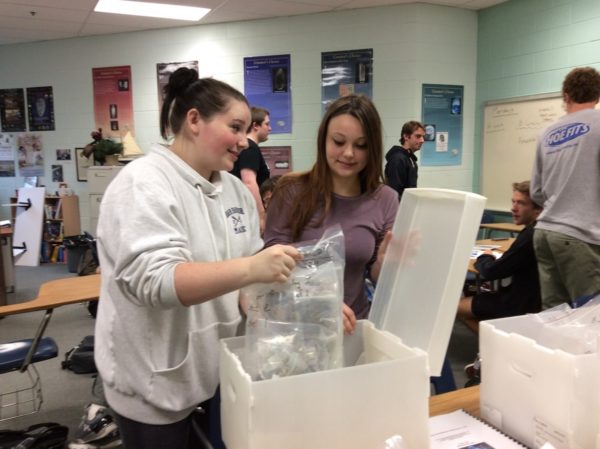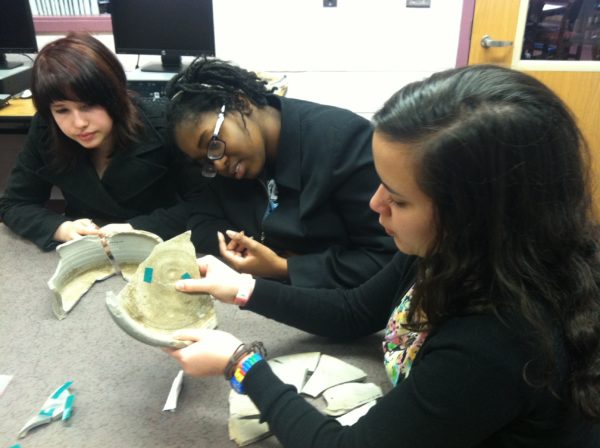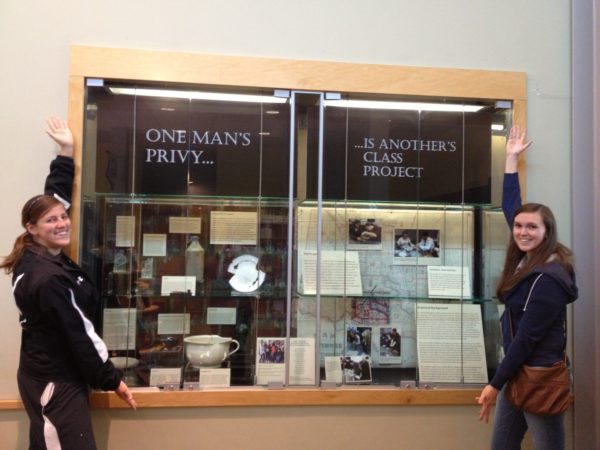By Patricia Samford, Maryland Archaeological Conservation Laboratory, Jefferson Patterson Park and Museum
Several years ago, I told a colleague that I was working with a group of high school students, cataloging and writing up a mid-19th century privy assemblage, excavated forty years ago in Baltimore. She was aghast, insisting that the students would surely screw something up and asking why I would even consider working with students that young. I politely reminded her that the freshmen enrolled in her field school were only a year or two older than my students – so I didn’t really see any great difference in what we were doing. In fact, when students are interested and engaged, working closely with professional archaeologists, there is no more reason to worry about the accuracy of their work than there is with college students. High school teachers are often looking for these types of hands-on, real world learning activities for their students. Finding a willing and flexible school educator and committing the time to work with students can yield great results for everyone.

For the last seven years, archaeologists and educators at Jefferson Patterson Park and Museum, Maryland’s State Museum of Archaeology, have been working with the Calvert County Public School system to provide archaeological opportunities for students at one of the county’s high schools. The park is home to Maryland’s archaeological curation facility—the Maryland Archaeological Conservation Laboratory—and, as such, is easily able to offer students the opportunity to work with an artifact collection each year. The site we have been focusing on – the Federal Reserve Site (18BC27)—encompassed a full city block in Baltimore and the 1980 excavation uncovered the subsurface remains of approximately fifty privies and row house cellars. Each year, the lab’s archaeologists choose a discrete assemblage—usually a privy with two or three boxes of artifacts—for the students to work with.

Throughout the course of the year, students work weekly with museum staff to catalog, mend and research the assemblage’s artifacts. As the capstones to their project, the students give a public presentation on their work, as well as plan and create a small exhibit for the public library and their school. During the process of analyzing an artifact assemblage from start to finish, the students gain valuable skills in writing, research, teamwork and public speaking. The Maryland Archaeological Laboratory benefits from having an understudied archaeological assemblage cataloged and analyzed.
Of course, conducting a program of this type is not without its challenges and park staff have learned over the course of the last seven years how to create an environment that facilitates learning and success. The lessons below relate generally to collections-based projects like those we have been conducting with the students at Huntingtown High School, but could be applied to fieldwork-based projects as well. Some of the lessons we have learned include:
- Don’t assume the students will have any background knowledge at all about archaeology, site formation processes or how to interpret artifact data. Be prepared to have the “no, archaeology is not about dinosaurs” talk and use lots of visuals to help students understand how archaeologists work.
- If possible, take a visit to an active archaeological site or an archaeological laboratory to see work in process. Visits like this will help students understand better the processes involved with archaeology.
- Limit the size of the student group based on the number of staff you have working with the students. A ratio of one staff to three or four students worked well for us.
- We learned to pare back on our original overall project goals – for example, it was very quickly became apparent that the time constraints posed by the school year and MAC Lab staff availability made it unrealistic to expect the students to write a technical report on their feature.
- Activities that involve working with the actual objects are going to be more popular and engaging than tasks that involve writing or researching. Find ways to make these less hands-on tasks more enticing by relating them to people from the past. Our students were particularly interested in doing research with online census data and with newspapers.
- Closely monitor research activities – kids will want to do all research on their phones and often choose sources that are unreliable.
- Build in more time than you think you need for tasks—at least twice as much as you would for a beginning professional. Things like standardized testing and the lack of focus during the pre-holiday periods mean that productivity declines (for everyone!).
- An important component of our project was incorporating ways to improve writing and public presentation skills. Be ready to offer constructive criticism in a supportive environment.
- Realize that you are not going to get as much focus the last month of school as you have the remainder of the year and plan accordingly.

Sometimes, as I leave a stack of work towering on my desk as I depart for the journey to the school, I wonder why the lab got involved in a project that demands so much of our time and energy. But, when I reach the school, and see the enthusiasm with which the students approach this project, I know that we have made the right decision. And, the students’ enthusiasm always reminds me why I got into archaeology in the first place—that excitement that we feel when we engage with the past. Two years ago, the students got so interested in the family whose trash we were studying that they used Ancestry.com to track down and contact living descendants to tell them about their project. And what makes the past come alive more than that?

